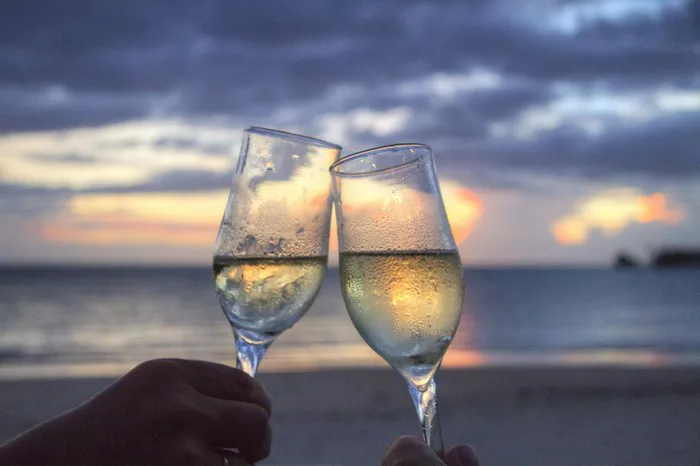Introduction to Champagne:
Champagne, often referred to as the epitome of luxury and celebration, is much more than just a sparkling wine; it’s a symbol of sophistication and refinement. Originating from the Champagne region of France, this effervescent beverage has gained global acclaim for its exquisite taste and versatility. Crafted through a meticulous process of secondary fermentation, champagne is characterized by its delicate bubbles, crisp acidity, and complex flavors.
Flavor Profile of Champagne:
Understanding the flavor profile of champagne is crucial in successfully pairing it with food. Typically, champagne exhibits a spectrum of aromas ranging from citrus fruits like lemon and grapefruit to floral notes such as jasmine and elderflower. On the palate, it boasts refreshing acidity with hints of green apple, pear, and sometimes subtle nuttiness from extended aging on lees. The effervescence adds a lively texture, cleansing the palate with each sip and leaving a lingering, satisfying finish.
Pairing Suggestions:
Pairing champagne with food is an art form that involves balancing flavors, textures, and aromas to create harmonious culinary experiences. The key lies in complementing the wine’s acidity and effervescence while enhancing its nuanced flavors. Here are some general guidelines for successful champagne pairings:
Acidity Matching: Champagne’s high acidity makes it an excellent palate cleanser, cutting through rich and fatty dishes. Pair it with foods that have a similar level of acidity, such as ceviche, oysters, or goat cheese, to maintain balance on the palate.
Contrast and Complement: Look for flavors that either contrast or complement those found in champagne. For example, the zesty acidity of champagne can contrast beautifully with creamy dishes like risotto or complement the delicate flavors of seafood and sushi.
Texture Play: Consider the texture of both the food and the champagne. Creamy textures in food can be balanced by the wine’s effervescence, while crisp, fried foods can be elevated by champagne’s acidity and bubbles.
Regional Pairings: Champagne’s versatility allows it to pair well with a variety of cuisines, but it particularly shines when paired with French classics such as oysters, caviar, or buttery pastries like croissants.
Pairing Examples:
To illustrate the versatility of champagne in food pairings, let’s explore some specific examples:
Oysters and Champagne: This classic pairing showcases the synergy between briny oysters and the crisp acidity of champagne. The wine’s effervescence enhances the oysters’ delicate flavors while cleansing the palate between each luxurious bite.
Fried Chicken and Champagne: The contrast between crunchy fried chicken and the lively bubbles of champagne creates a delightful sensory experience. The wine’s acidity cuts through the richness of the chicken, leaving you craving for more with each sip.
Sushi and Champagne: The clean, subtle flavors of sushi harmonize beautifully with the crisp acidity of champagne. Whether you’re indulging in delicate sashimi or savory rolls, champagne elevates the dining experience, leaving a refreshing and satisfying finish.
Temperature and Eating Techniques:
Proper serving temperature and eating techniques are essential for maximizing the enjoyment of champagne and food pairings. Here are some tips to ensure an exquisite culinary experience:
Champagne Temperature: Serve champagne chilled but not too cold, ideally between 45°F to 48°F (7°C to 9°C). Over-chilling can dull the wine’s aromas and flavors, so consider letting it sit for a few minutes after removing it from the refrigerator.
Glassware: Use tall, narrow champagne flutes to showcase the wine’s effervescence and preserve its bubbles. The flute’s shape also helps concentrate the aromas, enhancing the overall tasting experience.
Sipping Techniques: When enjoying champagne with food, take small sips between bites to cleanse the palate and prepare it for the next flavor sensation. Avoid swishing the wine in your mouth excessively, as it can diminish the bubbles and alter the wine’s texture.
Experiments and Personal Preferences:
While general guidelines can provide a starting point for champagne pairings, experimenting with different combinations is key to discovering your personal preferences. Don’t be afraid to venture outside traditional pairings and trust your instincts. Keep notes on what works well together and what doesn’t, allowing you to refine your pairing skills over time.
Additionally, consider the occasion and ambiance when selecting champagne and food pairings. Whether you’re hosting an intimate dinner party or celebrating a special milestone, tailor your choices to create memorable moments that delight the senses and elevate the overall experience.
In Conclusion
Pairing champagne with food is a delightful journey of exploration and discovery. By understanding the wine’s flavor profile, experimenting with diverse combinations, and honing your tasting skills, you can create unforgettable culinary experiences that captivate the palate and celebrate life’s finest moments. Cheers to the art of champagne pairing!


